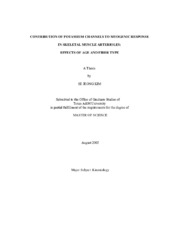| dc.description.abstract | In isolated skeletal muscle arterioles, increasing transmural pressure causes an
increase in constriction. This active myogenic response varies with age and fiber type.
Increased transmural pressure activates both Ca2+-activated (KCa) potassium channels and
voltage-dependent (Kv) potassium channels; these channels have a role in the negativefeedback
pathways that modulate depolarization and myogenic constriction. We tested
the hypothesis that increased KCa channel and Kv channel activity contribute to reduced
myogenic responsiveness in skeletal muscle arterioles of aged rats. 1A arterioles were
isolated from soleus, an oxidative muscle, and superficial gastrocnemius, a glycolytic
muscle, of young (4 mos) and aged (24 mos) Fischer 344 rats. Myogenic responses were
assessed by increasing intraluminal pressure (0-140 cm H2O) in increments of 20cm H2O.
Vasoconstrictor response were determined in response to increasing concentrations of the
KCa channel blocker, charybdotoxin (CTX; 10-10 to 10-7 M) and the Kv channel blocker,
4-Aminopyridine (4-AP; 10-5 to 10-2 M). To determine the role of potassium channels in
modulating the myogenic response, cannulated arterioles from soleus and gastrocnemius
were incubated with CTX (50 nM) and 4-AP (5mM) for 15 minutes prior to evaluation of
the myogenic response. Increased Kv channel activity contributes to reduced myogenic constriction in soleus and gastrocnemius muscle arterioles from aged rats. In soleus
muscle arterioles, KCa channel activity opposes myogenic tone in young but not old rats.
In gastrocnemius muscle arterioles, treatment with CTX did not eliminate age-related
differences in the myogenic response, and the KCa channel contribution to myogenic tone
was, in fact, greater arterioles from young as compared to old rats. Kv channels contribute
to greater myogenic constriction in soleus arterioles, KCa channels appear to be more
active in gastrocnemius muscle arterioles as compared to soleus muscle arterioles.
Therefore Kv and KCa channels are tonically active in skeletal muscle arterioles,
contributing to a hyperpolarizing force that opposes myogenic constriction. Furthermore,
increased Kv channel activity contributes to the age-related reduction of myogenic
constriction in soleus and gastrocnemius muscle arterioles. | en |


